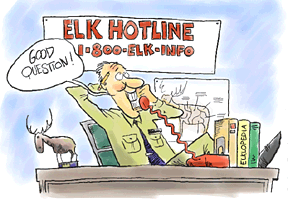Staffing the Elk Hotline

You may find it hard to believe, but one of the first things I
thought of when I visited an elk refuge was customer support. And
in particular, the patience telephone staff need when they hear
the same questions repeatedly.
This story takes us to Wyoming several ski seasons ago. During
a skiing break at Jackson Hole, my husband and I visited a refuge
where elk congregate between summer seasons.
The high point of this visit was a tour by horse-drawn sleigh
that gave us a close-up view of what elk do in the winter, which
is mostly nothing. They just lie around looking bored.
Occasionally, they buck horns, just like managers.
During the course of this 45-minute ride, people asked the
guide lots of questions. What do elk eat? How much does an elk
weigh? What do the antlers signify? You know, elk questions.
The guide answered each question enthusiastically, as if he
had just heard it for the first time. Afterward, when we were out
of the path of beasts that looked at us hungrily. I asked the
guide how many of these questions he had heard before. All of
them, he said. And how many had he heard frequently? All of them.
How did he manage to answer every question with enthusiasm and
still retain his sanity.
He said he just got used to it; it was part of his job.
So there we were in the middle of an elk refuge, and what
struck me was how this fellow’s job was similar to a customer
support job. If that’s your job, you may hear the same questions
over and over. And even though you may have heard the same
question 3,000 times before, you don’t hold it again the person
who unknowingly becomes the 3,001st (do you?).
But is it satisfying to repeat yourself for a living? (My job?
I answer questions about the location of the on-off switch.) Most
likely, you excel at responding to frequently asked questions,
but do you also aim to minimize the number of times any
particular question is asked?
If you really want to minimize repeat questions, then with
each question you hear, you must ask yourself, How can I make
this the last time I hear this question? (The two most common
answers — destroying all the phones and catching the next flight
to Tahiti — may not be permitted in some companies.)
Therefore, every question that’s asked more than a few times
should trigger two actions: First, respond to the question.
Second, think about steps to take so that customers have access
to the answers without having to contact you. You needn’t worry
that you’ll succeed so well that they’ll soon have no more
questions. Not a chance!
I can envision a sign posted on the sleigh at the elk refuge.
It’s labeled, Frequently Asked Questions About Elk, and in bold
letters, it says:
* What do elk eat? They eat . . .
* What do elk
weigh? They average . . .
* What do the antlers
signify? They grow . . .
Probably the tour guide wouldn’t want this sign in his sleigh.
Why? Guiding the elk sleigh is not the most challenging job. So
although he may get bored answering the same questions
repeatedly, he probably likes answering them better than the
alternative — dead silence.
That’s a situation you’ve probably never experienced.

